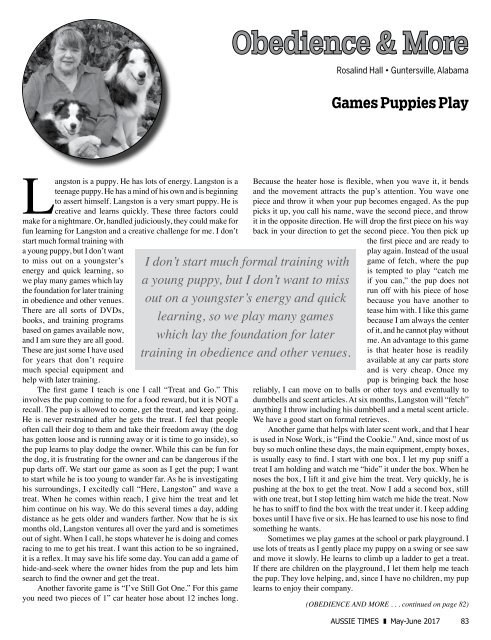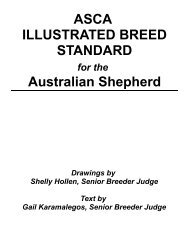Create successful ePaper yourself
Turn your PDF publications into a flip-book with our unique Google optimized e-Paper software.
Obedience & More<br />
Rosalind Hall • Guntersville, Alabama<br />
Games Puppies Play<br />
Langston is a puppy. He has lots of energy. Langston is a<br />
teenage puppy. He has a mind of his own and is beginning<br />
to assert himself. Langston is a very smart puppy. He is<br />
creative and learns quickly. These three factors could<br />
make for a nightmare. Or, handled judiciously, they could make for<br />
fun learning for Langston and a creative challenge for me. I don’t<br />
start much formal training with<br />
a young puppy, but I don’t want<br />
to miss out on a youngster’s<br />
energy and quick learning, so<br />
we play many games which lay<br />
the foundation for later training<br />
in obedience and other venues.<br />
There are all sorts of DVDs,<br />
books, and training programs<br />
based on games available now,<br />
and I am sure they are all good.<br />
These are just some I have used<br />
for years that don’t require<br />
much special equipment and<br />
help with later training.<br />
The first game I teach is one I call “Treat and Go.” This<br />
involves the pup coming to me for a food reward, but it is NOT a<br />
recall. The pup is allowed to come, get the treat, and keep going.<br />
He is never restrained after he gets the treat. I feel that people<br />
often call their dog to them and take their freedom away (the dog<br />
has gotten loose and is running away or it is time to go inside), so<br />
the pup learns to play dodge the owner. While this can be fun for<br />
the dog, it is frustrating for the owner and can be dangerous if the<br />
pup darts off. We start our game as soon as I get the pup; I want<br />
to start while he is too young to wander far. As he is investigating<br />
his surroundings, I excitedly call “Here, Langston” and wave a<br />
treat. When he comes within reach, I give him the treat and let<br />
him continue on his way. We do this several times a day, adding<br />
distance as he gets older and wanders farther. Now that he is six<br />
months old, Langston ventures all over the yard and is sometimes<br />
out of sight. When I call, he stops whatever he is doing and comes<br />
racing to me to get his treat. I want this action to be so ingrained,<br />
it is a reflex. It may save his life some day. You can add a game of<br />
hide-and-seek where the owner hides from the pup and lets him<br />
search to find the owner and get the treat.<br />
Another favorite game is “I’ve Still Got One.” For this game<br />
you need two pieces of 1” car heater hose about 12 inches long.<br />
I don’t start much formal training with<br />
a young puppy, but I don’t want to miss<br />
out on a youngster’s energy and quick<br />
learning, so we play many games<br />
which lay the foundation for later<br />
training in obedience and other venues.<br />
Because the heater hose is flexible, when you wave it, it bends<br />
and the movement attracts the pup’s attention. You wave one<br />
piece and throw it when your pup becomes engaged. As the pup<br />
picks it up, you call his name, wave the second piece, and throw<br />
it in the opposite direction. He will drop the first piece on his way<br />
back in your direction to get the second piece. You then pick up<br />
the first piece and are ready to<br />
play again. Instead of the usual<br />
game of fetch, where the pup<br />
is tempted to play “catch me<br />
if you can,” the pup does not<br />
run off with his piece of hose<br />
because you have another to<br />
tease him with. I like this game<br />
because I am always the center<br />
of it, and he cannot play without<br />
me. An advantage to this game<br />
is that heater hose is readily<br />
available at any car parts store<br />
and is very cheap. Once my<br />
pup is bringing back the hose<br />
reliably, I can move on to balls or other toys and eventually to<br />
dumbbells and scent articles. At six months, Langston will “fetch”<br />
anything I throw including his dumbbell and a metal scent article.<br />
We have a good start on formal retrieves.<br />
Another game that helps with later scent work, and that I hear<br />
is used in Nose Work, is “Find the Cookie.” And, since most of us<br />
buy so much online these days, the main equipment, empty boxes,<br />
is usually easy to find. I start with one box. I let my pup sniff a<br />
treat I am holding and watch me “hide” it under the box. When he<br />
noses the box, I lift it and give him the treat. Very quickly, he is<br />
pushing at the box to get the treat. Now I add a second box, still<br />
with one treat, but I stop letting him watch me hide the treat. Now<br />
he has to sniff to find the box with the treat under it. I keep adding<br />
boxes until I have five or six. He has learned to use his nose to find<br />
something he wants.<br />
Sometimes we play games at the school or park playground. I<br />
use lots of treats as I gently place my puppy on a swing or see saw<br />
and move it slowly. He learns to climb up a ladder to get a treat.<br />
If there are children on the playground, I let them help me teach<br />
the pup. They love helping, and, since I have no children, my pup<br />
learns to enjoy their company.<br />
(OBEDIENCE AND MORE . . . continued on page 82)<br />
AUSSIE TIMES May-June <strong>2017</strong> 83



